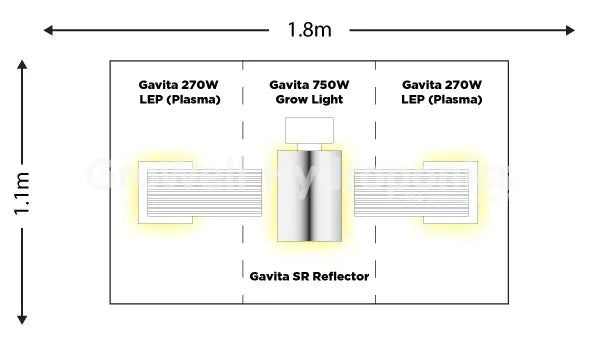
Grow Lights: The Easy Way To Shape Growth & Boost Yield
If you are what you eat, so are your plants - the type of light they use shapes the way they grow, look, taste and flower.
Use the right light, at the right time, and you’ll get bigger, better yielding plants that look, smell and taste nicer.
For Basic Growth:
For growth, plants use wavelengths of light between 400 – 700nm (The PAR range).
- Blue wavelengths for vegetative growth (around 400nm - 460nm)
- Red wavelengths for flowering (around 580nm - 700nm)

Lamps for Vegetative Growth
- Dual Spectrum Lamp: Red and blue light
Or
- Metal Halide (MH) Lamps: Mostly blue light
Lamps for Flowering
- Dual Spectrum Lamp: Red and blue light
Or
- High Intensity Sodium (HPS) Lamps: Mostly red light
Lamps for Propagation
Propagating plants are very delicate. They need blue wavelengths of light, but at a low intensity so that they stay compact and aren’t overpowered.
- Blue Fluorescent Lamps: Low intensity blue light for delicate, propagating plants
Most growers will use a fluorescent light when propagating then use a dual spectrum light for the rest of their cycle.
To Boost Yield Size, Quality, Taste & Aroma:
Like people, plants thrive on a varied diet or – in plant terms – a broad light spectrum.
Though wavelengths outside the PAR range aren’t used for growth, they play a key role in overall plant health. Specifically, UV-A (280 – 215nm) and UV-B (315 – 400nm) are known to:
- Improve the taste, aroma, size and appearance of fruit and flowers
- Boost resistance to pests and diseases
- Enhance the medicinal properties of plants

To really get the benefits of a wider spectrum, you need to use a supplemental grow light. Unlike standard grow lights, they mostly emit wavelengths outside the PAR range.
It doesn’t have to cost the earth to use them - they’re low intensity, cheap to run and don’t emit much heat.
You don’t have to create a brand new lighting layout either – you can retrofit a Maxibright CDM light (option 1) into your existing grow room
Option 1: 315W Maxibright 315W CDM Lighting System
- Uses a 315W Philips 942 Daylight CDM Lamp (you can also use a 315W Philips 930 Agro CDM Lamp)
- Positon between 2 x 600W lights
- 1.7 µmol per watt
- Can retrofit into any room you’ve got
Option 2: The Ultimate 270W Gavita Pro E-Series LEP (Plasma) Complete Lighting Systems
- Uses Gavita’s LEP (Light Emitting Plasma Bulb)
- Position 2 x 270W Gavita Plasma LEP Light on either side of a 6/750W Gavita light.
- 1.15 µmol/Watt
- Exceptionally broad light spectrum
- Compatible with Gavita Master Controllers and E-Series Lights
Remember, your PPF reading (µMol/Watt) only tells you how many particles of light from inside the PAR range are emitted by your grow light per second. It doesn’t tell you how many particles from outside the PAR range are emitted.
LEP (plasma) grow lights have a broader light spectrum, and emit much more light from outside the PAR range than CDM lights, but less light from inside the PAR range, which is why they have a lower PPF reading. They’re by far the best ones for broadening your light spectrum.
Prolong Vegetative Growth for Bigger, Healthier Plants
A typical growing cycle looks something like:
- 2 weeks: propagation
- 4 weeks: vegetative growth
- 8 weeks: flowering
Plants do most of their growing during the vegetative stage, where they reach 1/2 – 2/3 of their full size.
They still continue to grow in size during the first 2-4 weeks of flowering, and will often stop gaining height around weeks 4 -5.
To produce bigger, stronger plants that can support heavier fruits and flowers, you can grow fewer larger plants and prolong the vegetative growth phase.

To do this, continue running a Metal Halide or HPS Dual Spectrum grow light for 18-20 hrs a day. This mimics the seasonal conditions that short day plants normally grow in when in a vegetative state.
Plants won’t start to flower until you start running a 12 on/12 off light cycle - during this phase it is best to use a HPS lamp, ideally a Dual Spectrum HPS.
If you want to keep a mother plant – she must be kept in constant vegetative growth – if you let her flower you will no longer be able to take cuttings from her.
Stay at Your Best
It’s no secret that every % of light lost results in around a 1% loss of yield. One of the easiest and cheapest ways of maximising your yield is replacing your lamps and reflectors regularly.
Most lamps need replacing every 6 months, most reflectors every year.





